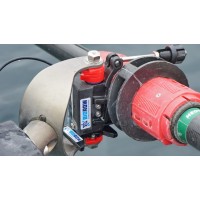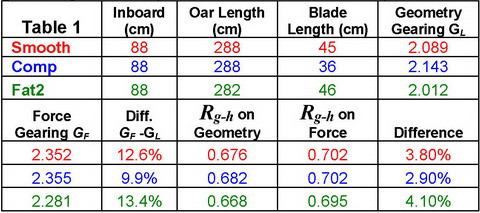Determination of rowing power

Rowing power is the most important indicator of performance in our sport, and new findings from our latest blades research may help to provide more accurate calculation of rowing power and feedback on it. If the force is measured at the gate Fg, then the handle force Fh is derived as:
Fh = Fg Lout / Loar = Fg Lout / (Lin + Lout) (1)
where Lout and Lin are the effective outboard and inboard, and Loar is their sum - the effective oar length. Effective levers are measured at the points of force application at the handle, pin and blade. Before, it was assumed that these forces are applied at the centres of the handle and blade (Fig.1).

Our recent experiments have shown that the above assumption could be perfected to make force and power evaluation more accurate. It was found that the centre of force application (CFA) at the handle tends to be slightly further away from the top of the handle than its centre (RBN 2020/10-11). On average, in sculling, CFA was found at about 8cm from the handle top instead of the previously used 6cm, which makes effective inboard shorter and the gearing heavier. This was possibly due to the specifics of measured scullers, but based on our observations, most scullers tend to grip the handle similarly further inwards from its centre, so 8cm could be used for calculations. For sweep oars, no CFA data has yet been obtained, so the previous standard 15cm should still be used.
CFA of the gate force is fixed at the centre of the oarlock, which is 2cm away from the outer surface of the button, where the inboard is measured. So, 2cm should be added for effective inboard and subtracted for effective outboard.
It was found that CFA at the blade is located further away from the pin than the blade geometry centre, about 10-12cm from its outer edge. This makes the effective outboard longer and the gearing heavier. The gearing ratio is defined with the measured forces (GF = Fh / Fbl) was found 9-13% heavier than the gearing defined with levers (GL = Lout / Lin) based on oar geometry centres (RBN 2021/10 and Table 1).

The above findings suggest that the coefficient of conversion of the gate to handle forces RF = Fh/Fg is higher than the previous one based on the oar geometry RG= Loar/Lout: by 3.8% for Smooth blades, 2.9% for Comps, and 4.1% for Fat2. This means the rower’s power production could be on average 3.6% higher that readings from systems with gate force measurements. This partly explains higher power values on-erg compare to on-water rowing, which has much more complex mechanics. In addition to above gearing factor, there are many other factors affecting power production and measurements on-water: rower’s asymmetry, boat stability, synchronisation in a crew, which can create an effect of “power transfer though the boat” (RBN 2012/04).
It is important to remember that the above conclusions can be used only for on-the-water rowing, but not in a rowing tank or Swingulator. Recently, an article was published (1), where various rowing electronic systems were validated in an experiment using a Swingulator. In this case, at the same handle force, the gate force is nearly twice as high as in a boat, because the outboard is much shorter the Swingulator (62.5cm) than in a boat (about 260 cm). Say, at 100 kgF maximal handle force, the gate force in a boat would be about 140 kgF, but on Swingulator it is 270 kgF. The EmPower oarlock was designed for a rowing boat, made of light aluminium to reduce its weight, so on Swingulator, the oarlock sensor works outside designed range of forces. The data for force above the range could be simply missing or non-linear and incorrect, which invalidates the results of the referred study. Other systems compared were less/not affected by this specifics of the Swingulator, because they measure the handle force on inboard (WEBA system).
This was not the only flaw of the study: the authors failed to provide information on how they configured the rigging settings in the studied systems. Also, power calculation for their reference system was ambiguous and incorrect: all mechanical energy produced by a rower is transferred through the Swingulator cable to the attached ergometer, so calculations are very simple and straightforward - power is a product of the measured force by the cable speed. However, instead it was confused with adjustment for gate angles, the reason for which is unclear and was not explained. The study is therefore seriously flawed and requires significant revision on the points addressed so as to not be misleading, and to fulfil basic scientific criteria.
References: 1. Holt AC, Hopkins WG, Aughey RJ, Siegel R, Rouillard V and Ball K (2021) Concurrent Validity of Power From Three On-Water Rowing Instrumentation Systems and a Concept2 Ergometer. Front. Physiol. 12:758015. doi: 10.3389/fphys.2021.758015.
©2022 Dr. Valery Kleshnev www.biorow.com



